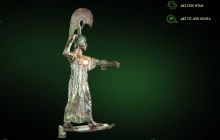Athena, Goddess of the Acropolis: An interactive application in education and culture

A remarkable interactive application in culture stands out among the digital collections at NISRT (National Information System for Research and Technology). “Athena, Goddess of the Acropolis” is the application that opens the virtual doors of the museum of Acropolis and offers its visitors a unique experience in the world of the museum.
In Greek mythology, Athena was the goddess of wisdom and heroic endeavor, courage, inspiration, civilization, strategy, and justice. In her life, the goodness protected whatever was related to culture, wisdom, the arts and crafts, fine arts, philosophical thought and also the art of war. Athens is her city; the olive tree, created by her, is her tree; the owl, is the birth consecrated to her. The Athenians founded the Parthenon on the Acropolis of her namesake city, Athens (Athena Parthenos), in her honour.
At NIRST (Digital Culture section), the Goddess of Athena welcomes visitors to her game and invites them to search for the 15 depictions of Athena (dedications, offerings, statues, reliefs, pottery etc.). These artifacts are some of the most important architectural sculptures of the Acropolis with themes drawn from the mythology of the goodness Athena. To find these artifacts, visitors of the application, have to navigate through the corridors of the museum (at its different levels: e.g. Archaic Period, 5th Century BC) and follow the light which will unravel the statues. Along with the statue and its full description (e.g. size, dimensions) the application provides information about the story which surrounds the myth of its creation.
e.g Palladium (Height 22,7, Date 575-550 BC): ''At the end of the Trojan War, the Argives took the Palladium from the Temble of Athena in Troy. In the course of its journey, however, the Athenian king Demophon stole it and took it to Athens. Yet it was not placed on the Acropolis, but in the area near the Olympeion where cases of murder through negligence were tried and which afterwards became known as the Palladium. The Palladium and the myths are depicted in the north and south metopes of the Parthenon.'
Users can resize the object and view it from different angles. Impressive graphics are accompanied by sound. The application is also available in English. It has been developed due to a generous grant from the Bodosakis Foundations, and it has been the result of a collaboration of the Acropolis Restoration Service and the 1st Ephorate Prehistoric and Classical Antiquities. The National Documentation Center of Greece (EKT) hosts the digital application in its information systems.
|
|
|








